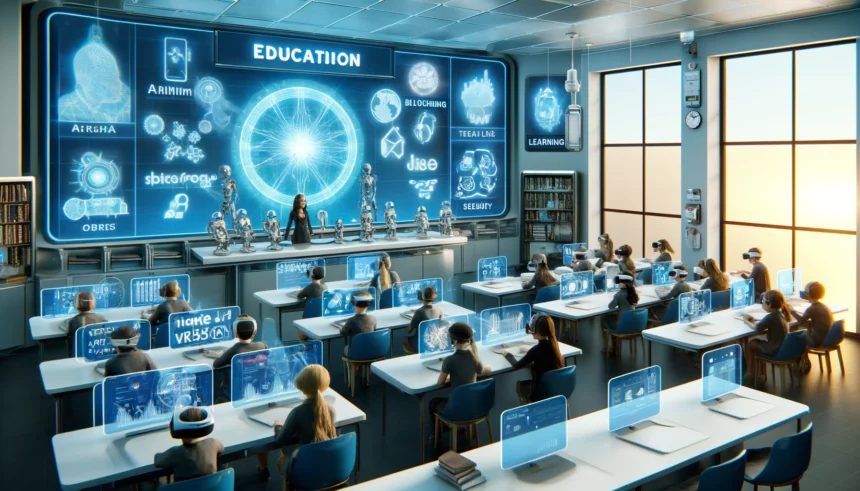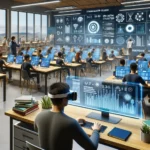The education sector is poised for a significant transformation driven by innovative technologies. The shift towards digital classrooms has shown that tech is no longer a luxury but a vital part of education, enhancing both learning experiences and outcomes. This article explores key technologies set to shape education in the near future. From virtual reality to blockchain, these tools promise a more inclusive, efficient, and engaging educational environment.
The Current State of Educational Technology
In recent years, educational technology has expanded rapidly, bringing a range of tools like learning management systems (LMS), interactive whiteboards, and digital assessment tools. These have significantly changed traditional educational methods. However, the evolution of educational technology is ongoing, making it crucial for educators to stay updated with new advancements.
Why Staying Updated Matters
Keeping up with emerging technologies is essential for educators aiming to provide relevant and engaging learning experiences. It ensures students acquire the latest skills and knowledge, preparing them for future challenges.
Key Technologies Reshaping Education
Virtual and Augmented Reality (VR/AR) in Classrooms
- Immersive Learning Experiences: VR and AR create immersive learning environments. Imagine history lessons where students walk through ancient Rome or biology classes where they explore the human bloodstream—all from their classroom seats. These technologies make learning more engaging and memorable.
- Practical Applications: Schools around the world are already using VR/AR. For instance, a school in Sweden uses AR to help students understand complex chemical processes that are hard to grasp through traditional methods.
- Challenges and Solutions: The main challenges with VR/AR are the high costs and need for specialized equipment. Schools can tackle these issues by starting with scalable programs, seeking partnerships for funding, and training teachers to use these technologies effectively.
Artificial Intelligence (AI) and Personalized Learning
- Adaptive Learning Platforms: AI-powered platforms customize learning paths based on individual student performance, helping to address each student’s unique needs and increasing engagement.
- AI Tutors and Assistants: AI tutors provide extra support outside the classroom, offering personalized feedback and helping students learn at their own pace.
- Ethical Considerations: While AI offers many benefits, it’s crucial to handle its integration carefully, focusing on data privacy and ethical use. Educators should ensure transparency and protect student information.
Blockchain Technology in Education
- Securing Academic Credentials: Blockchain can transform the way academic credentials are stored and shared, making verification faster and more secure. This ensures student records are safe and easily accessible to authorized institutions.
- Decentralized Education Resources: Blockchain enables the global sharing of educational resources, breaking down geographical and economic barriers and democratizing education.
- Future Prospects: Blockchain could streamline various administrative processes in education, leading to more efficient management of educational institutions.
Learning Analytics and Data-Driven Education
- Monitoring Student Progress: Educational data analysis tools help track student progress, providing insights that can improve teaching strategies and student outcomes.
- Tailoring Educational Content: Data-driven insights allow educators to continuously refine curricula and teaching methods to better meet student needs.
- Privacy and Data Security: While beneficial, the use of data in education raises privacy concerns. Schools must implement strict data security measures and maintain transparency with stakeholders.
Internet of Things (IoT) in Smart Educational Environments
- Connected Classrooms: IoT can turn classrooms into dynamic learning environments with synchronized smart devices enhancing learning experiences, from smart boards to automated attendance systems.
- IoT for Safety and Efficiency: Beyond learning, IoT improves campus safety and operational efficiency, with smart lighting systems reducing energy consumption and surveillance systems enhancing security.
- Implementation Challenges: Integrating IoT in education faces challenges like technical issues and high initial costs. Strategic planning and pilot projects can help demonstrate value and address these challenges.
Looking Ahead: Adapting to Future Technologies
Emerging technologies are advancing quickly, and they will play a crucial role in future education settings. Educators need to remain adaptable, continually updating their skills and knowledge to keep pace with technological changes.
Conclusion
The future of education is bright with these transformative technologies. As educators and institutions embrace these tools, they will enhance learning experiences and empower students to succeed in a digital world.
FAQs
What are the most cost-effective educational technologies for low-budget schools?
- Low-budget schools can start by integrating open-source platforms and tools, which often provide robust features without high costs.
How can educators ensure that technology is inclusive and benefits all students?
- Inclusivity involves providing accessible resources for all students, including those with disabilities, and ensuring comprehensive training in using new technologies.
What are the professional development needs for teachers adapting to new technologies?
- Teachers need ongoing training and support in using emerging technologies, covering technical skills and integration strategies within the curriculum.
















